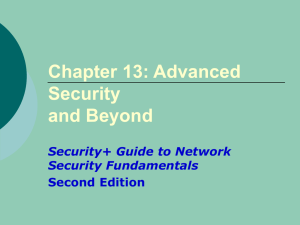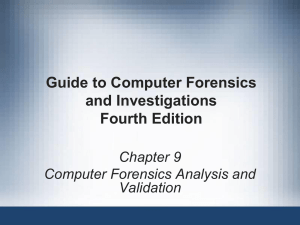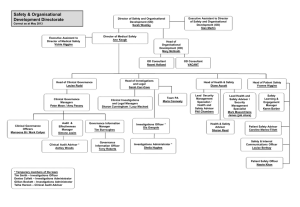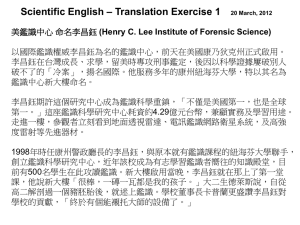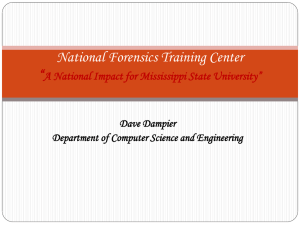Chapter 4
advertisement
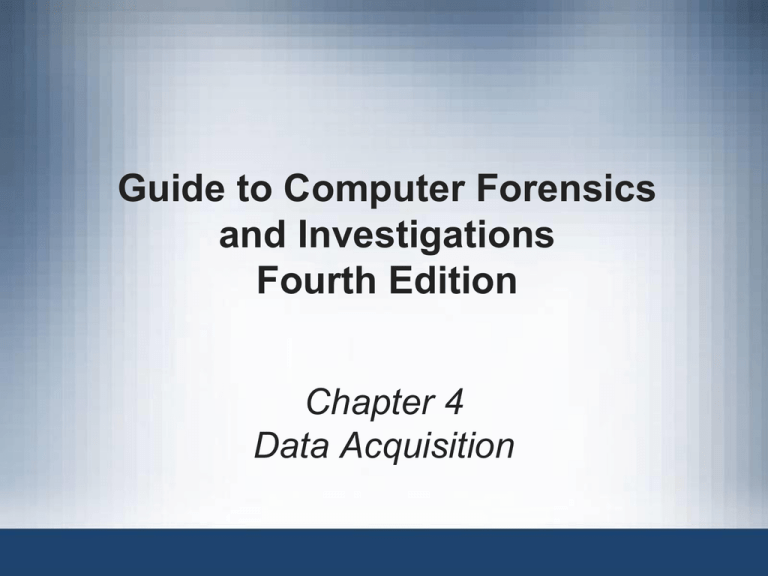
Guide to Computer Forensics and Investigations Fourth Edition Chapter 4 Data Acquisition Objectives • List digital evidence storage formats • Explain ways to determine the best acquisition method • Describe contingency planning for data acquisitions • Explain how to use acquisition tools Guide to Computer Forensics and Investigations 2 Objectives (continued) • Explain how to validate data acquisitions • Describe RAID acquisition methods • Explain how to use remote network acquisition tools • List other forensic tools available for data acquisitions Guide to Computer Forensics and Investigations 3 Understanding Storage Formats for Digital Evidence • Three formats – Raw format – Proprietary formats – Advanced Forensics Format (AFF) Guide to Computer Forensics and Investigations 4 Raw Format • Makes it possible to write bit-stream data to files • Advantages – Fast data transfers – Can ignore minor data read errors on source drive – Most computer forensics tools can read raw format • Disadvantages – Requires as much storage as original disk or data – Tools might not collect marginal (bad) sectors Guide to Computer Forensics and Investigations 5 Proprietary Formats • Features offered – Option to compress or not compress image files – Can split an image into smaller segmented files – Can integrate metadata into the image file • Disadvantages – Inability to share an image between different tools – File size limitation for each segmented volume Guide to Computer Forensics and Investigations 6 Advanced Forensics Format • Developed by Dr. Simson L. Garfinkel of Basis Technology Corporation • Design goals – Provide compressed or uncompressed image files – No size restriction for disk-to-image files – Provide space in the image file or segmented files for metadata – Simple design with extensibility – Open source for multiple platforms and OSs Guide to Computer Forensics and Investigations 7 Advanced Forensics Format (continued) • Design goals (continued) – Internal consistency checks for self-authentication • File extensions include .afd for segmented image files and .afm for AFF metadata • AFF is open source Guide to Computer Forensics and Investigations 8 Determining the Best Acquisition Method • Types of acquisitions – Static acquisitions and live acquisitions • Four methods – – – – Bit-stream disk-to-image file Bit-stream disk-to-disk Logical disk-to-disk or disk-to-disk data Sparse data copy of a file or folder Guide to Computer Forensics and Investigations 9 Determining the Best Acquisition Method (continued) • Bit-stream disk-to-image file – – – – Most common method Can make more than one copy Copies are bit-for-bit replications of the original drive ProDiscover, EnCase, FTK, SMART, Sleuth Kit, XWays, iLook • Bit-stream disk-to-disk – When disk-to-image copy is not possible – Consider disk’s geometry configuration – EnCase, SafeBack, SnapCopy Guide to Computer Forensics and Investigations 10 Determining the Best Acquisition Method (continued) • Logical acquisition or sparse acquisition – When your time is limited – Logical acquisition captures only specific files of interest to the case – Sparse acquisition also collects fragments of unallocated (deleted) data – For large disks – PST or OST mail files, RAID servers Guide to Computer Forensics and Investigations 11 Determining the Best Acquisition Method (continued) • When making a copy, consider: – Size of the source disk • Lossless compression might be useful • Use digital signatures for verification – When working with large drives, an alternative is using tape backup systems – Whether you can retain the disk Guide to Computer Forensics and Investigations 12 Contingency Planning for Image Acquisitions • Create a duplicate copy of your evidence image file • Make at least two images of digital evidence – Use different tools or techniques • Copy host protected area of a disk drive as well – Consider using a hardware acquisition tool that can access the drive at the BIOS level • Be prepared to deal with encrypted drives – Whole disk encryption feature in Windows Vista Ultimate and Enterprise editions Guide to Computer Forensics and Investigations 13 Using Acquisition Tools • Acquisition tools for Windows – Advantages • Make acquiring evidence from a suspect drive more convenient – Especially when used with hot-swappable devices – Disadvantages • Must protect acquired data with a well-tested writeblocking hardware device • Tools can’t acquire data from a disk’s host protected area Guide to Computer Forensics and Investigations 14 Windows XP Write-Protection with USB Devices • USB write-protection feature – Blocks any writing to USB devices • Target drive needs to be connected to an internal PATA (IDE), SATA, or SCSI controller • Steps to update the Registry for Windows XP SP2 – Back up the Registry – Modify the Registry with the write-protection feature – Create two desktop icons to automate switching between enabling and disabling writes to USB device Guide to Computer Forensics and Investigations 15 Windows XP Write-Protection with USB Devices (continued) Guide to Computer Forensics and Investigations 16 Acquiring Data with a Linux Boot CD • Linux can access a drive that isn’t mounted • Windows OSs and newer Linux automatically mount and access a drive • Forensic Linux Live CDs don’t access media automatically – Which eliminates the need for a write-blocker • Using Linux Live CD Distributions – Forensic Linux Live CDs • Contain additionally utilities Guide to Computer Forensics and Investigations 17 Acquiring Data with a Linux Boot CD (continued) • Using Linux Live CD Distributions (continued) – Forensic Linux Live CDs (continued) • Configured not to mount, or to mount as read-only, any connected storage media • Well-designed Linux Live CDs for computer forensics – Helix – Penguin Sleuth – FCCU • Preparing a target drive for acquisition in Linux – Linux distributions can create Microsoft FAT and NTFS partition tables Guide to Computer Forensics and Investigations 18 Acquiring Data with a Linux Boot CD (continued) • Preparing a target drive for acquisition in Linux (continued) – fdisk command lists, creates, deletes, and verifies partitions in Linux – mkfs.msdos command formats a FAT file system from Linux • Acquiring data with dd in Linux – dd (“data dump”) command • Can read and write from media device and data file • Creates raw format file that most computer forensics analysis tools can read Guide to Computer Forensics and Investigations 19 Acquiring Data with a Linux Boot CD (continued) • Acquiring data with dd in Linux (continued) – Shortcomings of dd command • Requires more advanced skills than average user • Does not compress data – dd command combined with the split command • Segments output into separate volumes • Acquiring data with dcfldd in Linux – dd command is intended as a data management tool • Not designed for forensics acquisitions Guide to Computer Forensics and Investigations 20 Acquiring Data with a Linux Boot CD (continued) • Acquiring data with dcfldd in Linux (continued) – dcfldd additional functions • • • • Specify hex patterns or text for clearing disk space Log errors to an output file for analysis and review Use several hashing options Refer to a status display indicating the progress of the acquisition in bytes • Split data acquisitions into segmented volumes with numeric extensions • Verify acquired data with original disk or media data Guide to Computer Forensics and Investigations 21 Capturing an Image with ProDiscover Basic • Connecting the suspect’s drive to your workstation – – – – – Document the chain of evidence for the drive Remove the drive from the suspect’s computer Configure the suspect drive’s jumpers as needed Connect the suspect drive Create a storage folder on the target drive • Using ProDiscover’s Proprietary Acquisition Format – Image file will be split into segments of 650MB – Creates image files with an .eve extension, a log file (.log extension), and a special inventory file (.pds extension) Guide to Computer Forensics and Investigations 22 Capturing an Image with ProDiscover Basic (continued) Guide to Computer Forensics and Investigations 23 Guide to Computer Forensics and Investigations 24 Capturing an Image with ProDiscover Basic (continued) • Using ProDiscover’s Raw Acquisition Format – Select the UNIX style dd format in the Image Format list box – Raw acquisition saves only the image data and hash value Guide to Computer Forensics and Investigations 25 Capturing an Image with AccessData FTK Imager • Included on AccessData Forensic Toolkit • View evidence disks and disk-to-image files • Makes disk-to-image copies of evidence drives – At logical partition and physical drive level – Can segment the image file • Evidence drive must have a hardware writeblocking device – Or the USB write-protection Registry feature enabled • FTK Imager can’t acquire drive’s host protected area Guide to Computer Forensics and Investigations 26 Capturing an Image with AccessData FTK Imager (continued) Guide to Computer Forensics and Investigations 27 Capturing an Image with AccessData FTK Imager (continued) • Steps – – – – – Boot to Windows Connect evidence disk to a write-blocker Connect target disk to write-blocker Start FTK Imager Create Disk Image • Use Physical Drive option Guide to Computer Forensics and Investigations 28 Capturing an Image with AccessData FTK Imager (continued) Guide to Computer Forensics and Investigations 29 Capturing an Image with AccessData FTK Imager (continued) Guide to Computer Forensics and Investigations 30 Capturing an Image with AccessData FTK Imager (continued) Guide to Computer Forensics and Investigations 31 Capturing an Image with AccessData FTK Imager (continued) Guide to Computer Forensics and Investigations 32 Validating Data Acquisitions • Most critical aspect of computer forensics • Requires using a hashing algorithm utility • Validation techniques – CRC-32, MD5, and SHA-1 to SHA-512 Guide to Computer Forensics and Investigations 33 Linux Validation Methods • Validating dd acquired data – You can use md5sum or sha1sum utilities – md5sum or sha1sum utilities should be run on all suspect disks and volumes or segmented volumes • Validating dcfldd acquired data – Use the hash option to designate a hashing algorithm of md5, sha1, sha256, sha384, or sha512 – hashlog option outputs hash results to a text file that can be stored with the image files – vf (verify file) option compares the image file to the original medium Guide to Computer Forensics and Investigations 34 Windows Validation Methods • Windows has no built-in hashing algorithm tools for computer forensics – Third-party utilities can be used • Commercial computer forensics programs also have built-in validation features – Each program has its own validation technique • Raw format image files don’t contain metadata – Separate manual validation is recommended for all raw acquisitions Guide to Computer Forensics and Investigations 35 Performing RAID Data Acquisitions • Size is the biggest concern – Many RAID systems now have terabytes of data Guide to Computer Forensics and Investigations 36 Understanding RAID • Redundant array of independent (formerly “inexpensive”) disks (RAID) – Computer configuration involving two or more disks – Originally developed as a data-redundancy measure • RAID 0 – Provides rapid access and increased storage – Lack of redundancy • RAID 1 – Designed for data recovery – More expensive than RAID 0 Guide to Computer Forensics and Investigations 37 Understanding RAID (continued) • RAID 2 – – – – Similar to RAID 1 Data is written to a disk on a bit level Has better data integrity checking than RAID 0 Slower than RAID 0 • RAID 3 – Uses data stripping and dedicated parity • RAID 4 – Data is written in blocks Guide to Computer Forensics and Investigations 38 Understanding RAID (continued) Guide to Computer Forensics and Investigations 39 Understanding RAID (continued) Guide to Computer Forensics and Investigations 40 Understanding RAID (continued) Guide to Computer Forensics and Investigations 41 Understanding RAID (continued) • RAID 5 – Similar to RAIDs 0 and 3 – Places parity recovery data on each disk • RAID 6 – Redundant parity on each disk • RAID 10, or mirrored striping – Also known as RAID 1+0 – Combination of RAID 1 and RAID 0 Guide to Computer Forensics and Investigations 42 Understanding RAID (continued) Guide to Computer Forensics and Investigations 43 Acquiring RAID Disks • Concerns – – – – – How much data storage is needed? What type of RAID is used? Do you have the right acquisition tool? Can the tool read a forensically copied RAID image? Can the tool read split data saves of each RAID disk? • Older hardware-firmware RAID systems can be a challenge when you’re making an image Guide to Computer Forensics and Investigations 44 Acquiring RAID Disks (continued) • Vendors offering RAID acquisition functions – – – – – Technologies Pathways ProDiscover Guidance Software EnCase X-Ways Forensics Runtime Software R-Tools Technologies • Occasionally, a RAID system is too large for a static acquisition – Retrieve only the data relevant to the investigation with the sparse or logical acquisition method Guide to Computer Forensics and Investigations 45 Using Remote Network Acquisition Tools • You can remotely connect to a suspect computer via a network connection and copy data from it • Remote acquisition tools vary in configurations and capabilities • Drawbacks – LAN’s data transfer speeds and routing table conflicts could cause problems – Gaining the permissions needed to access more secure subnets – Heavy traffic could cause delays and errors Guide to Computer Forensics and Investigations 46 Remote Acquisition with ProDiscover • With ProDiscover Investigator you can: – – – – – Preview a suspect’s drive remotely while it’s in use Perform a live acquisition Encrypt the connection Copy the suspect computer’s RAM Use the optional stealth mode • ProDiscover Incident Response additional functions – Capture volatile system state information – Analyze current running processes Guide to Computer Forensics and Investigations 47 Remote Acquisition with ProDiscover (continued) • ProDiscover Incident Response additional functions (continued) – – – – Locate unseen files and processes Remotely view and listen to IP ports Run hash comparisons Create a hash inventory of all files remotely • PDServer remote agent – ProDiscover utility for remote access – Needs to be loaded on the suspect Guide to Computer Forensics and Investigations 48 Remote Acquisition with ProDiscover (continued) • PDServer installation modes – Trusted CD – Preinstallation – Pushing out and running remotely • PDServer can run in a stealth mode – Can change process name to appear as OS function Guide to Computer Forensics and Investigations 49 Remote Acquisition with ProDiscover (continued) • Remote connection security features – – – – – Password Protection Encryption Secure Communication Protocol Write Protected Trusted Binaries Digital Signatures Guide to Computer Forensics and Investigations 50 Remote Acquisition with EnCase Enterprise • Remote acquisition features – Remote data acquisition of a computer’s media and RAM data – Integration with intrusion detection system (IDS) tools – Options to create an image of data from one or more systems – Preview of systems – A wide range of file system formats – RAID support for both hardware and software Guide to Computer Forensics and Investigations 51 Remote Acquisition with R-Tools RStudio • R-Tools suite of software is designed for data recovery • Remote connection uses Triple Data Encryption Standard (3DES) encryption • Creates raw format acquisitions • Supports various file systems Guide to Computer Forensics and Investigations 52 Remote Acquisition with Runtime Software • Utilities – DiskExplorer for FAT – DiskExplorer for NTFS – HDHOST • Features for acquisition – Create a raw format image file – Segment the raw format or compressed image – Access network computers’ drives Guide to Computer Forensics and Investigations 53 Using Other Forensics-Acquisition Tools • Tools – – – – – – – SnapBack DatArrest SafeBack DIBS USA RAID ILook Investigator IXimager Vogon International SDi32 ASRData SMART Australian Department of Defence PyFlag Guide to Computer Forensics and Investigations 54 SnapBack DatArrest • Columbia Data Products • Old MS-DOS tool • Can make an image on three ways – Disk to SCSI drive – Disk to network drive – Disk to disk • Fits on a forensic boot floppy • SnapCopy adjusts disk geometry Guide to Computer Forensics and Investigations 55 NTI SafeBack • • • • Reliable MS-DOS tool Small enough to fit on a forensic boot floppy Performs an SHA-256 calculation per sector copied Creates a log file Guide to Computer Forensics and Investigations 56 NTI SafeBack (continued) • Functions – Disk-to-image copy (image can be on tape) – Disk-to-disk copy (adjusts target geometry) • Parallel port laplink can be used – Copies a partition to an image file – Compresses image files Guide to Computer Forensics and Investigations 57 DIBS USA RAID • Rapid Action Imaging Device (RAID) – Makes forensically sound disk copies – Portable computer system designed to make disk-todisk images – Copied disk can then be attached to a write-blocker device Guide to Computer Forensics and Investigations 58 ILook Investigator IXimager • Iximager – Runs from a bootable floppy or CD – Designed to work only with ILook Investigator – Can acquire single drives and RAID drives Guide to Computer Forensics and Investigations 59 Vogon International SDi32 • Creates a raw format image of a drive • Write-blocker is needed when using this tool • Password Cracker POD – Device that removes the password on a drive’s firmware card Guide to Computer Forensics and Investigations 60 ASRData SMART • Linux forensics analysis tool that can make image files of a suspect drive • Capabilities – – – – Robust data reading of bad sectors on drives Mounting suspect drives in write-protected mode Mounting target drives in read/write mode Optional compression schemes Guide to Computer Forensics and Investigations 61 Australian Department of Defence PyFlag • PyFlag tool – Intended as a network forensics analysis tool – Can create proprietary format Expert Witness image files – Uses sgzip and gzip in Linux Guide to Computer Forensics and Investigations 62 Summary • Data acquisition methods – – – – Disk-to-image file Disk-to-disk copy Logical disk-to-disk or disk-to-data file Sparse data copy • Several tools available – Lossless compression is acceptable • Plan your digital evidence contingencies • Write-blocking devices or utilities must be used with GUI acquisition tools Guide to Computer Forensics and Investigations 63 Summary (continued) • Always validate acquisition • A Linux Live CD, such as Helix, provides many useful tools for computer forensics acquisitions • Preferred Linux acquisition tool is dcfldd (not dd) • Use a physical write-blocker device for acquisitions • To acquire RAID disks, determine the type of RAID – And then which acquisition tool to use Guide to Computer Forensics and Investigations 64

